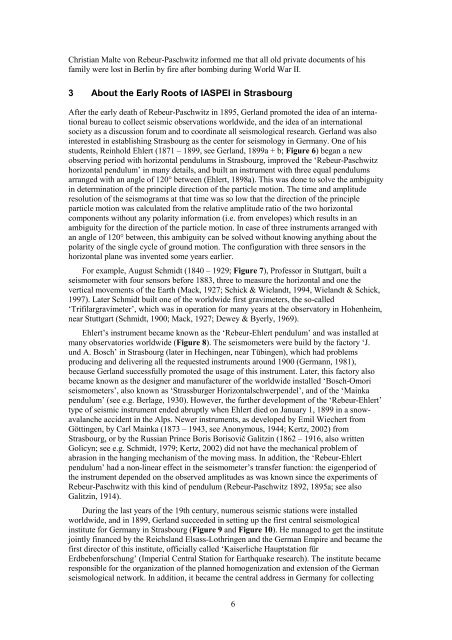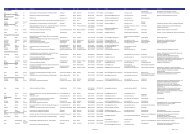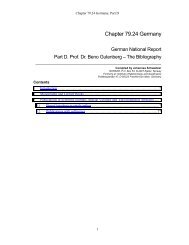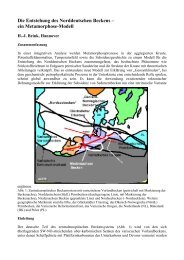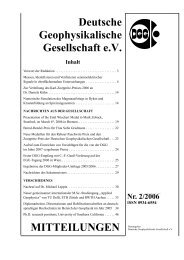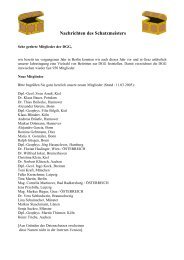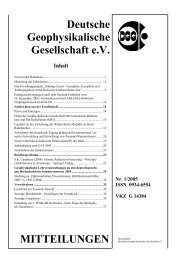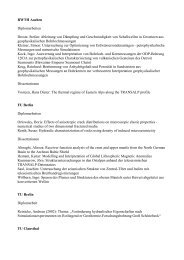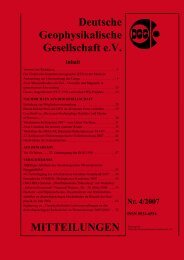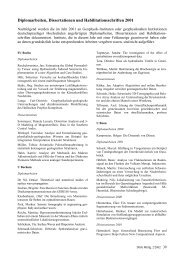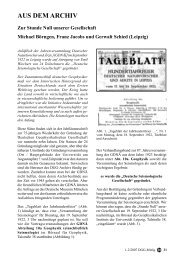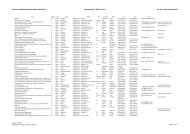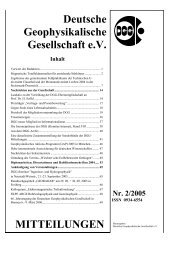Early Contributions to Modern Seismology - Deutsche ...
Early Contributions to Modern Seismology - Deutsche ...
Early Contributions to Modern Seismology - Deutsche ...
You also want an ePaper? Increase the reach of your titles
YUMPU automatically turns print PDFs into web optimized ePapers that Google loves.
Christian Malte von Rebeur-Paschwitz informed me that all old private documents of his<br />
family were lost in Berlin by fire after bombing during World War II.<br />
3 About the <strong>Early</strong> Roots of IASPEI in Strasbourg<br />
After the early death of Rebeur-Paschwitz in 1895, Gerland promoted the idea of an international<br />
bureau <strong>to</strong> collect seismic observations worldwide, and the idea of an international<br />
society as a discussion forum and <strong>to</strong> coordinate all seismological research. Gerland was also<br />
interested in establishing Strasbourg as the center for seismology in Germany. One of his<br />
students, Reinhold Ehlert (1871 – 1899, see Gerland, 1899a + b; Figure 6) began a new<br />
observing period with horizontal pendulums in Strasbourg, improved the ‘Rebeur-Paschwitz<br />
horizontal pendulum’ in many details, and built an instrument with three equal pendulums<br />
arranged with an angle of 120° between (Ehlert, 1898a). This was done <strong>to</strong> solve the ambiguity<br />
in determination of the principle direction of the particle motion. The time and amplitude<br />
resolution of the seismograms at that time was so low that the direction of the principle<br />
particle motion was calculated from the relative amplitude ratio of the two horizontal<br />
components without any polarity information (i.e. from envelopes) which results in an<br />
ambiguity for the direction of the particle motion. In case of three instruments arranged with<br />
an angle of 120° between, this ambiguity can be solved without knowing anything about the<br />
polarity of the single cycle of ground motion. The configuration with three sensors in the<br />
horizontal plane was invented some years earlier.<br />
For example, August Schmidt (1840 – 1929; Figure 7), Professor in Stuttgart, built a<br />
seismometer with four sensors before 1883, three <strong>to</strong> measure the horizontal and one the<br />
vertical movements of the Earth (Mack, 1927; Schick & Wielandt, 1994, Wielandt & Schick,<br />
1997). Later Schmidt built one of the worldwide first gravimeters, the so-called<br />
‘Trifilargravimeter’, which was in operation for many years at the observa<strong>to</strong>ry in Hohenheim,<br />
near Stuttgart (Schmidt, 1900; Mack, 1927; Dewey & Byerly, 1969).<br />
Ehlert’s instrument became known as the ‘Rebeur-Ehlert pendulum’ and was installed at<br />
many observa<strong>to</strong>ries worldwide (Figure 8). The seismometers were build by the fac<strong>to</strong>ry ‘J.<br />
und A. Bosch’ in Strasbourg (later in Hechingen, near Tübingen), which had problems<br />
producing and delivering all the requested instruments around 1900 (Germann, 1981),<br />
because Gerland successfully promoted the usage of this instrument. Later, this fac<strong>to</strong>ry also<br />
became known as the designer and manufacturer of the worldwide installed ‘Bosch-Omori<br />
seismometers’, also known as ‘Strassburger Horizontalschwerpendel’, and of the ‘Mainka<br />
pendulum’ (see e.g. Berlage, 1930). However, the further development of the ‘Rebeur-Ehlert’<br />
type of seismic instrument ended abruptly when Ehlert died on January 1, 1899 in a snowavalanche<br />
accident in the Alps. Newer instruments, as developed by Emil Wiechert from<br />
Göttingen, by Carl Mainka (1873 – 1943, see Anonymous, 1944; Kertz, 2002) from<br />
Strasbourg, or by the Russian Prince Boris Borisovič Galitzin (1862 – 1916, also written<br />
Golicyn; see e.g. Schmidt, 1979; Kertz, 2002) did not have the mechanical problem of<br />
abrasion in the hanging mechanism of the moving mass. In addition, the ‘Rebeur-Ehlert<br />
pendulum’ had a non-linear effect in the seismometer’s transfer function: the eigenperiod of<br />
the instrument depended on the observed amplitudes as was known since the experiments of<br />
Rebeur-Paschwitz with this kind of pendulum (Rebeur-Paschwitz 1892, 1895a; see also<br />
Galitzin, 1914).<br />
During the last years of the 19th century, numerous seismic stations were installed<br />
worldwide, and in 1899, Gerland succeeded in setting up the first central seismological<br />
institute for Germany in Strasbourg (Figure 9 and Figure 10). He managed <strong>to</strong> get the institute<br />
jointly financed by the Reichsland Elsass-Lothringen and the German Empire and became the<br />
first direc<strong>to</strong>r of this institute, officially called ‘Kaiserliche Hauptstation für<br />
Erdbebenforschung’ (Imperial Central Station for Earthquake research). The institute became<br />
responsible for the organization of the planned homogenization and extension of the German<br />
seismological network. In addition, it became the central address in Germany for collecting<br />
6


